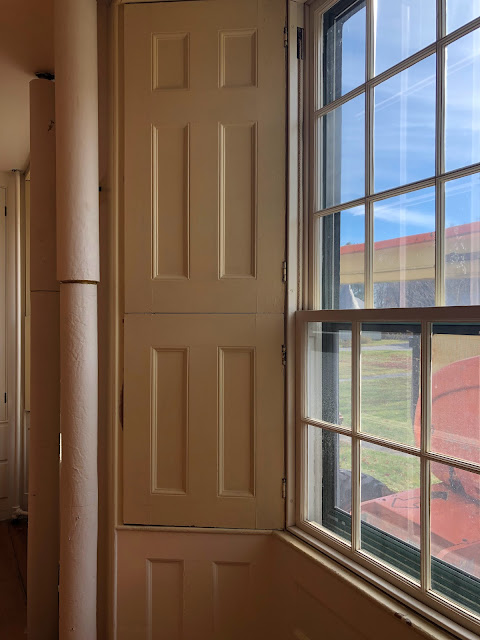One particular Shaker settlement is the Enfield Shakers, Enfield, New Hampshire. They owned and farmed over 3,000 acres. In Mount Lebanon, NY, they had a successful seed business. The Shakers were the first to package seeds for sale. They create innovations in marketing seeds, distributing them, packaging and cataloging which lead to lasting change in the horticultural business forever.
They also did broom making. On site at Enfield, is a building that is being renovated to house the broom making. Did you know a good broom will stand up on its own? Their’s all do. They sell all the different varieties of brooms they make in the gift shop and they also offer a 3 hour class to make your own broom!
Also onsite, the 1854 cow barn…..mainly full of pigeons now.
In the next building, Shaker clothing is on display as well as The Tempestry Project.
The Tempestry Project started in Washington State in 2017. Because climate change is always a difficult topic, crafters used their medium to ‘chart’ temperature patterns and changes. In Enfield, they knitted with worsted merino wool using a key with a different color to represent every degree.
Done in 10 year increments, they knitted a row to represent the average temperature for each day of one of the years in that decade.
The original site in Enfield had over 100 buildings which included the “Great Stone Dwelling”. The largest ever Shaker building which now houses the Museum. Due to declining membership, they were force to sell property in 1927. In property was sold again in 1985 by a private group of investors. In 1997, the Museum was able to repurchase the Chapel as well as other Enfield buildings.
This is the Chapel on the left and the Great Stone Dwelling on the right. The Chapel was build on a piece of land that was sold to the Our Lady of La Salette, an order of Catholic priests.
The Museum tour offers some great finds. Original “Dorothy” cloaks. Typical construction with hood and cape. These cloaks have “The Dorothy” labels inside the neckline. One of a couple different cloak patterns they used. Using this photo, the scene was re-created in the museum.


Shaker furniture
In the Dining Hall there are several examples of perforated paper stitched pieces.
Walls of built in cabinetry. Not a bit of wasted space!
Storage closet for dinner ware.
Shakers set their tables in sets of four so everything was in reach of each diner. Shakers ate in 15 minutes and there was no talking at the table. With everything within reach it wasn’t necessary to ask to have something passed to you.
Thick walls and their shutter ‘storage’ built in to the window casing.
The built-ins found in the bedrooms.
So much for a Shaker Village, now on to the project.
This sampler is believed to have been given by AW as a token of friendship to Emeline. Jennifer did extensive research and can determine that AW is most likely Ann Maria Wheeler. She lived in the Shaker Village for about a year. She left the Shaker Village near Albany, NY to rejoin her husband in Oswego, NY. Jennifer admitted the her’s is just speculation as far as the identity of AW. Emeline, on the other hand, has more information. She was born in 1793 and lived to be nearly 80 years old. She is buried in a Shaker Cemetery near Colonie, NY. Emeline would have had a busy life working various jobs as women played an active role in the Shaker community. Emeline served in a leadership role as an eldress of the community.
The original sampler is owned by the Western Historical Society, Cleveland, Ohio.





















What a fascinating presentation!
ReplyDelete